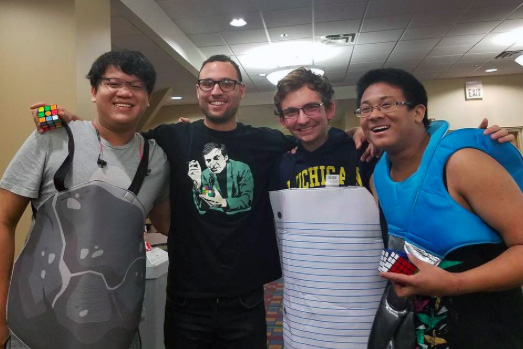Rubik's Cubes may be less popular now than during the 1980s, but the sport of solving those vexing 3D puzzles has only gotten more competitive.
Over a recent weekend, more than 100 puzzle solvers—“cubers” in modern parlance—met in the Chicago suburb of Villa Park for the Halloween-themed ChicaGhost cubing competition where one participant set a new world record of 4.59 seconds.
SeungBeom “Steve” Cho solved the puzzle so fast, it looked like even he was caught by surprise. His result beat the previous world record, which had stood for two and a half years, by a tenth of a second.
The 23-year-old Cho, who identifies himself as a "Korean speedcuber living in Illinois" on his YouTube profile, has participated in fewer than 20 official competitions, all in this state, according to his World Cube Association profile. Cho didn’t respond to messages for comment.
In some respects, Cho’s world record was serendipitous. Ryan Jew, a University of California- Berkeley senior who organized ChicaGhost, picked Villa Park on a whim. “We figured there aren't many competitions in Chicago even though it's an awesome city,” Jew says, adding that he and his co-organizer Eric Zhao, of New York, both travel to compete, roughly half of weekends of the year. “We actually don't get data on who is local, but I gathered because there were a lot of new people, they were within driving distance.”
Though anyone can organize a cubing event, a WCA delegate must officiate and validate the results to make them official. Roughly 80,000 people compete worldwide, and world championships are held every two years.
At 22, Jew is something of an elder statesman of cubing competitions, which have been growing in popularity over the last dozen years or so. He says they used to be mostly college-aged people, but has increasingly skewed younger over the years. His hypothesis: Who, other than young kids, have hours to burn watching cube solving tutorials on YouTube and practicing in their rooms?
“I think the average age now is 15. The bulk of people are 10 to 20,” Jew says. He noted cubing still isn’t very diverse demographically, though he wants that to change. “Other than age, it looks like an engineering class and is probably 95 percent male.”
That means the current crop of speed solvers was born long after the Rubik’s craze of the ‘80s had faded. Jew estimates the puzzle started to regain popularity around 2004 and really hit its stride in the past nine years, almost entirely thanks to YouTube. Social media on other platforms has only made it grow, with competitions being a flurry of tweets, snaps, and 'grams to capture the speedy rate of victory.

First-timers should find a cube that feels nice (Chinese brands meant for speed solving are the most popular), Jew says. After that, start competing as soon as you figure out how to solve a puzzle: “Having people there who can help you out or make you feel like you want to beat them can be really motivating," he says.
During ChicaGhost, there might be 15 cubers solving a puzzle at the same time, while the rest of the attendees mull around, spectate, or socialize. Jew says that Cho was “fairly casual about all of it” when he set the world record—considering that cubing competitions have a lot of false alarms with young kids yelling “world record!” in excitement before actually knowing the time.
Amid the intensity, Jew says competitions remain full of good sportsmanship and cubers who are sincerely happy to see someone else succeed.
“The community is full of people who genuinely have fun,” Jew says. “Ninety-nine percent of people are doing it because they want to it. We haven’t got to the point of where people have enemies. People are very genuine.”


